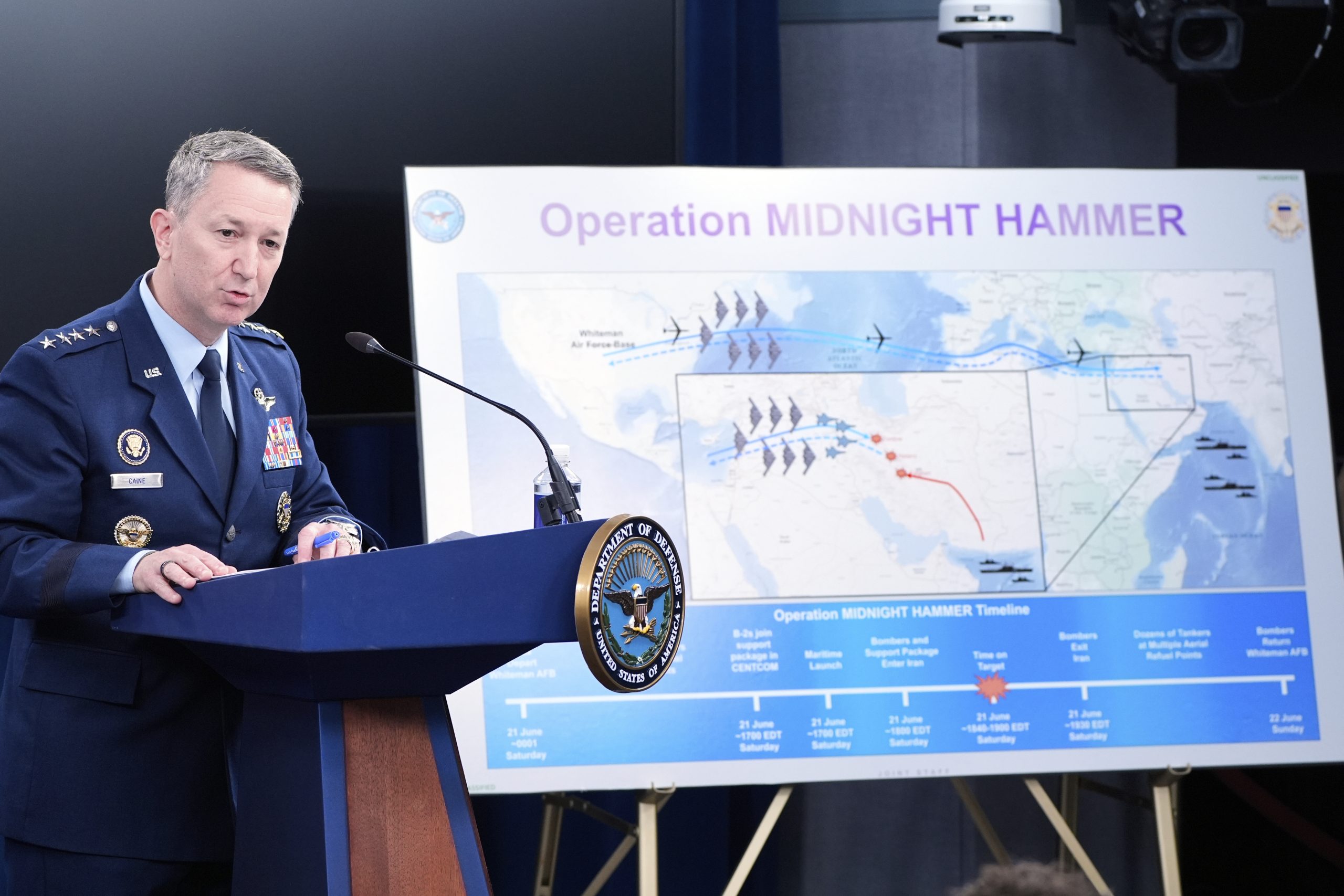The US military operation against Iran on Saturday involved more than 125 aircraft and a deception operation that saw bombers deployed over the Pacific as a “decoy”, Chairman of the Joint Chiefs of Staff General Dan Caine says.
Caine revealed new details on the mission, codenamed Operation Midnight Hammer, in a joint briefing with US Secretary of Defence Pete Hegseth at the Pentagon on Sunday morning (just after 10pm AEST).
Caine said the unprecedented operation involved seven stealth B2 bombers, and its goal — to destroy nuclear sites in Fordo, Natanz and Isfahan — had been achieved.
READ MORE: US ‘does not seek war’ after surprise attack on Iran, Hegseth says

“Final battle damage will take some time, but initial battle damage assessments indicate that all three sites sustained extremely severe damage and destruction,” Caine said.
Bombers dropped more than a dozen 30,000-pound (13.6-tonne) Massive Ordnance Penetrator bombs on two Iranian nuclear facilities, Fordow and Natanz, Caine said. Tomahawk missiles were launched at Isfahan.
All told, more than 125 aircraft were involved, including the B2s, refuelling tankers, reconnaissance planes and fighter jets.
The bombers struck Fordow, Natanz and Esfahan beginning at 6.40pm ET on Saturday (8.40am on Sunday AEST) and were out of Iranian airspace by 7pm ET, Caine said.
Flying from a base in Missouri, the mission was the longest B2 mission since just after the September 11 attacks.
Dozens of Tomahawk missiles were also launched at targets inside Iran as part of the operation, Caine said.
“At midnight Friday into Saturday morning, a large B-2 strike package comprised of bombers launched from the continental United States,” Caine said.
READ MORE: Iran warns US has begun a ‘dangerous war’

“As part of a plan to maintain tactical surprise, part of the package proceeded to the west and into the Pacific as a decoy — a deception effort known only to an extremely small number of planners and key leaders here in Washington and in Tampa.
“The main strike package comprised of seven B-2 Spirit bombers, each with two crew members, proceeded quietly to the east with minimal communications.”
Iran nuclear ambitions ‘obliterated’
Hegseth said that a choice to move a number of B-2 bombers from their base in Missouri earlier on Saturday was meant to be a decoy to throw off Iranians.
He added that the US used other methods of deception as well, deploying fighters to protect the B-2 bombers that dropped 14 bunker-buster bombs on Iran’s most powerful nuclear site.
He said that all of these tactics helped the US drop the bombs without tipping off Iran’s fighter jets or its air missile systems.
Iran’s nuclear ambitions “have been obliterated”, he said.
“The order we received from our commander in chief was focused, it was powerful, and it was clear,” Hegseth said from the Pentagon podium.
READ MORE: ‘Gone’: Inside Iran’s once-secretive Fordow nuclear site

“We devastated the Iranian nuclear program, but it’s worth noting the operation did not target Iranian troops or the Iranian people. … Thanks to President Trump’s bold and visionary leadership and his commitment to peace through strength, Iran’s nuclear ambitions have been obliterated.”
Operation Midnight Hammer timeline
Midnight ET (2pm on Sunday AEST): The operation began overnight Friday into Saturday morning, Caine said at a Pentagon news conference. As B-2 bombers launched from the US, some headed west as a decoy while the rest “proceeded quietly to the east with minimal communications throughout the 18-hour flight”.
About 5pm ET (7am on Sunday AEST): Caine said a US submarine “launched more than two dozen Tomahawk land attack cruise missiles against key surface infrastructure targets” at the Isfahan nuclear site in Iran.
As the B-2s entered Iranian airspace, the US “employed several deception tactics, including decoys, as the fourth- and fifth-generation aircraft pushed out in front of the strike package at high altitude and high speed, sweeping in front of the package for enemy fighters and surface-to-air missile threats,” Caine said.
He added that upon approach of the Natanz and Fordow facilities, the US employed “high-speed suppression weapons” with fighter aircraft to “ensure safe passage” of the B-2 bombers.
About 6.40pm ET (8.40am on Sunday AEST): The lead B-2 bomber launched two massive bunker-buster bombs at Fordow nuclear site, Caine said, and the “remaining bombers then hit their targets”.
Those additional targets were struck, Caine said, “between 6.40pm ET and 7.05pm ET” (8.40am and 9.05am on Sunday AEST).
That places the timing of these attacks about 2.10am local time in Iran on Sunday.
In total, Caine said, 16 GBU-57 Massive Ordnance Penetrators were dropped — two from the lead B-2 on Fordow, and 14 more from the remaining bombers against the two other sites.
Flight back to US: The US military then “began its return home”, Caine said, noting that no shots were fired by Iran at the US on the way in or out.
– Additional reporting by CNN